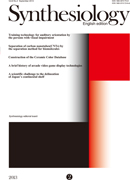Volume 6, Issue 2
Displaying 1-10 of 10 articles from this issue
- |<
- <
- 1
- >
- >|
Research papers
-
2013 Volume 6 Issue 2 Pages 66-74
Published: 2013
Released on J-STAGE: January 22, 2014
Download PDF (1814K) -
2013 Volume 6 Issue 2 Pages 75-83
Published: 2013
Released on J-STAGE: January 22, 2014
Download PDF (1929K) -
2013 Volume 6 Issue 2 Pages 84-93
Published: 2013
Released on J-STAGE: January 22, 2014
Download PDF (1649K) -
2013 Volume 6 Issue 2 Pages 94-104
Published: 2013
Released on J-STAGE: January 22, 2014
Download PDF (1760K) -
2013 Volume 6 Issue 2 Pages 105-121
Published: 2013
Released on J-STAGE: January 22, 2014
Download PDF (8642K)
Article
-
2013 Volume 6 Issue 2 Pages 122-128
Published: 2013
Released on J-STAGE: January 22, 2014
Download PDF (947K)
Report
-
2013 Volume 6 Issue 2 Pages 129-131
Published: 2013
Released on J-STAGE: January 22, 2014
Download PDF (801K)
Editorial board
-
2013 Volume 6 Issue 2 Pages 132-133
Published: 2013
Released on J-STAGE: January 22, 2014
Download PDF (251K) -
2013 Volume 6 Issue 2 Pages 134-135
Published: 2013
Released on J-STAGE: January 22, 2014
Download PDF (273K) -
2013 Volume 6 Issue 2 Pages 136
Published: 2013
Released on J-STAGE: January 22, 2014
Download PDF (250K)
- |<
- <
- 1
- >
- >|
